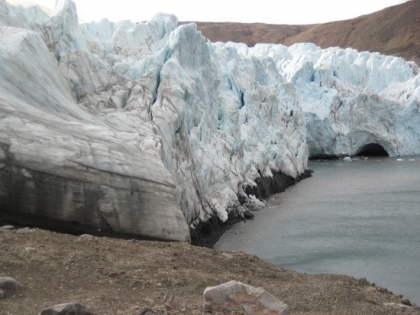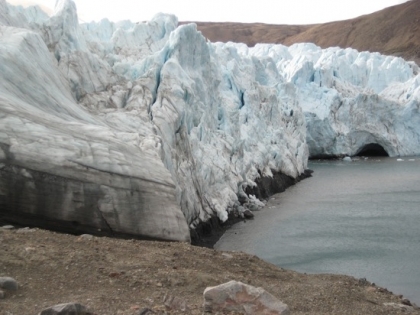A new study says melting ice sheets will likely be “the dominant contributor to sea level rise in the 21st century.”

About 110,000 years ago, global sea level began to drop as the planet cooled, and evaporating seawater was transformed into massive ice sheets that covered large parts of the Northern Hemisphere. About 10,000 years ago, the Earth warmed up again. The ice retreated dramatically, and sea level rose. Since then, the planet’s ice, and the level of the ocean have been more or less stable.
Not any more, though. Thanks largely to human-generated greenhouse gases, the ice that remains in mountain glaciers and ice caps — and more significantly, in the massive ice sheets that smother Antarctica and Greenland under frigid blankets up to two miles thick in places — is moving to the sea once again. Just how high and how fast global sea level will rise as a result is still uncertain, though. One big reason: scientists haven’t been able to get a firm handle on how ice melting has already changed as a consequence of the warming that’s already taken place.
A new paper in the journal Geophysical Research Letters is sure to help, though. Using two different measurement techniques, a team of geophysicists from the U.S. and Netherlands has shown that the ice in Antarctica and Greenland is not only vanishing into the sea: the rate of disappearance has been accelerating over an 18-year period, with about 36.3 billion metric tons more ice lost each year compared to the year before.
By 2006, a year in which a total of about 475 billion metric tons of ice were lost, the acceleration in ice mass loss from the ice sheets had already surpassed acceleration in ice mass loss from mountain glaciers and ice caps — and that lead is likely to grow over the coming century, the study indicates, to the point where ice sheets will be “the dominant contributor to sea level rise in the 21st century.”
What makes this study so important, says co-author Isabella Velicogna, of the University of California, Irvine and NASA’s Jet Propulsion Laboratory in Pasadena, is that the ice loss was measured in two entirely independent ways. The first involved the Gravity Recovery and Climate Experiment, or GRACE. It’s a pair of satellites that measure the local gravity at every spot on Earth. In both Greenland and Antarctica, the ice generates some of that gravity — and as the ice melts in response to warming air and ocean temperatures, the gravity diminishes. “GRACE basically weighs the ice every 30 days,” says Velicogna, “and sees how much it’s changing.”
How Do We Know: Greenland’s Melting Ice Sheet from Climate Central on Vimeo.
How Do We Know: Greenland’s Melting Ice Sheet from Climate Central on Vimeo.
The second technique looks at the ice sheets in the same way you’d look at your bank account. The deposits, in the form of snowfall, are calculated using a combination of observations and models that estimate annual precipitation. The withdrawals — physical shrinkage of the ice as it melts and as tidewater glaciers dump icebergs into the ocean — are measured with satellite-mounted radars. If you withdraw money faster than you deposit it, your bank balance shrinks. Similarly, if the shrinkage of the ice outpaces the growth from precipitation, the so-called “mass-balance” shrinks.
“There’s very solid agreement between the two [measurements],” says lead author Eric Rignot, also of UC-Irvine and NASA. And while the GRACE satellites have only been orbiting since 2000, that agreement gives the scientists confidence that the mass-balance estimates, which go back some 18 years, are reliable throughout that whole period.
What that means for sea-level rise over the coming century, however, is still unclear. However, in light of this study and other recent findings, the projections in the 2007 U.N. Intergovernmental Panel on Climate Change (IPCC) report of up to a half-meter of sea-level rise by 2100 may be too low. “If you take our 18 years of good records,” says Rignot, “and extend them forward, you’re going to get to a meter easily. Beyond that, it’s difficult to say.”
“It all depends,” says Rignot, “on whether the ice loss continues at this rate, or slows, or accelerates.”
Nevertheless, says Velicogna, “I personally don’t think it’s going to slow down. I believe we should be a little more concerned than we are now. It’s going to take many years to prepare for this degree of sea-level rise. It’s happening — so what are we going to do about it?”
Use the “Envisioning Ice Loss” tool to find out how recent Greenland ice loss would look if it occurred in your home state.
5 thoughts on “Melting Ice Sheets Spur Sea Level Rise”
Comments are closed.


Widespread Persistent Thickening of the East Antarctic Ice Sheet by Freezing from the Base
Abstract
An International Polar Year aerogeophysical investigation of the high interior of East Antarctica reveals widespread freeze-on that drives significant mass redistribution at the bottom of the ice sheet. While surface accumulation of snow remains the primary mechanism for ice sheet growth, beneath Dome A 24% of the base by area is frozen-on ice. In some places, up to half the ice thickness has been added from below.
These ice packages result from conductive cooling of water ponded near the Gamburtsev Subglacial Mountain ridges and supercooling of water forced up steep valley walls. Persistent freeze-on thickens the ice column, alters basal ice rheology and fabric and upwarps the overlying ice sheet, including the oldest atmospheric climate archive, and drives flow behavior not captured in present models.
REBUTTAL TO Russell Steele’s comments:
From the results published in the journal Nature Geoscience. (ANI)
Dr Adrian Jenkins of British Antarctic Survey – reports.
“We do not know what kick-started the initial retreat from the ice ridge, but we do know that it started some time prior to 1970.This work is vital for evaluating the risk of potential wide-spread collapse of West Antarctic glaciers,” he added.
Co-author Stan Jacobs added: “Since our first measurements in the Amundsen Sea, estimates of Antarctica’s recent contributions to sea level rise have changed from near-zero to significant and increasing. Now finding that the PIG’s grounding line has recently retreated more than 30 km from a shallow ridge into deeper water, where it is pursued by a warming ocean, only adds to our concern that this region is indeed the ‘weak underbelly’ of the West Antarctic Ice Sheet.
Increased melting of continental ice also appears to be the primary cause of persistent ocean freshening and other impacts, both locally and downstream in the Ross Sea.”
Unless we address population growth with family planning, and phase out urgently away of C02 producing energy consumption, the National Academy of Sciences and Dr. fenner (smal pox) predict humanity will become EXTINCT WITHIN 100-200 YEARS)
is the love for money, and fossil fuels such that hinders us from taking urgent action?
In response to Dr Kaplan:
GRACE has it’s own set of problems. And at least one model conlcusion has been revised post facto because the melt data is overestimated:
The melting of the ice sheets of Greenland and West Antarctica is about twice as slow as previously thought. The study, conducted by TU Delft, SRON and the Jet Propulsion Laboratory. The scientists published their findings in the September issue of Nature Geoscience.
We have concluded that the Greenland and West Antarctica ice caps are melting at approximately half the speed originally predicted.’ The average rise in sea levels as a result of the melting ice caps is also lower.
In fact, errors from GRACE may be quite large. So take this new release from JPL and the squawking about the forecasted sea level rise with a grain of salt. But more importantly, look at what the actual sea-level data is saying, and a Willis Eschenbach points out, natures seems to be Putting the Brakes on Acceleration: http://wattsupwiththat.com/2011/01/08/putting-the-brakes-on-acceleration/
In response to Russell Steele, the problems suggested with GRACE estimates of ice loss–at least, as I understand them–have to do with questions about how much the underlying bedrock is deformed by the ice. You can’t measure that directly, so it has to be modeled, and scientists legitimately differ on that modeling. According to Velicogna, though, the fact that the GRACE data shows accelerating mass loss over the past several years is significant, because whatever’s going in with the bedrock isn’t changing over that period. Any change, therefore, reflects a change in the ice itself.
Beyond that, the mass balance calculations in the new paper are completely independent of GRACE but show the same acceleration. It’s hard to imagine how two completely independent techniques could find the same answer if it were fundamentally invalid. Hard for me, anyway.